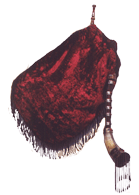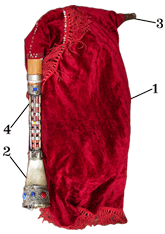
On the other side of the bag a wooden stock is attached into the bag. The chanter is inserted into the stock. There is a horn attached to the en of stock, in which two wooden pipes of equal length and thickness (“Dedani”) are placed - a leader and a bass(4). The left one is called “teller” or “beginner”, the right one is called “Mebane” (a deep voice producer). The pipes are made from apricot tree. The “beginner” pipe has six front-facing holes and Bass pipe has three front-facing holes. The three bottom holes of the left pipe are placed symmetrically across from the three holes of the right pipe. Inside of each pipe, from the top, there are inserted reeds made from cane. They produce instrument sound. It produces two-part chords and two-part tunes. The two part sounding are produced by the simultaneous playing of both pipes. Gudastviri’s diapason is minor seventh.
So, the reed pipes are fixed inside the horn. The horn is made of Caucasian goat or bull horn. The horn has the function of resonator as well. There is a ball of cotton wool inserted into the open end of the horn to absorb the moisture formed during playing. Gudastviri is decorated with silver bands, mounted with colored glass beads and numerous small chains. Gudastviri leather is put into the precious velvet material (bag). As usual red color.
The gudastviri is played throughout Georgia, and is especially popular in eastern and western regions of the country. The instrument is known by many different names, depending on region. In Imereti it is called a gudastrivi, but in the Racha region its name is “Stviri” or “Shtviri”. In Meskheti it is known as a “Tulumi.” In the Kartli and Pshavi regions, the instrument is called a “Stviri.” Inn Adjara it is a “Chiboni” or “Chimoni.” While most aspects of the instruments in all of these regions are the same, they differ slightly in timbre, the capacity of the guda (bag), and the number of holes in the chanter pipes.
In Kakheti this instrument was also called “Sazandari”. In this respect academician Iv. Djavakhishvili notes that “Sazandari” is a comparatively new town name of this instrument and at the same time an inadequate Persian name. This instrument is mentioned with the name “Gudastviri” in the Arabian legend “Leil Majnuani” translated by the king of Georgia Teimuraz I in the XVII century.
The six keys of the left reed pipe emit notes of the first octave: F, E, D, C, H, A, G; the three keys of the right one emit deep-voiced notes: C, H, A, G.
Tuning of the Kartlian gudastviri:
Pipe I: c1 - d1 - es1 - f1 - g1 - as1 - b1.
Pipe II: c1 - d1 - es1 - f1.
Tuning of the Rachian gudastviri:
Pipe I: c1 - d1 - es1 - f1 - g1 - as1 - b1.
Pipe II: c1 - d1 - es1 - f1.
Tuning of the Pshavian gudastviri:
Pipe I: c1 - d1 - es1 - f1 - g1 - as1 - b1.
Pipe II: c1 - d1
In the region of Javakheti (eastern part), Gudastviri pipes are made of very young branches of a dog-rose. One should possess special knowledge to design it. Jewelers make some articles of the instrument. Gudastviri itself is designed by its player, who knows where and how the articles should be attached.

